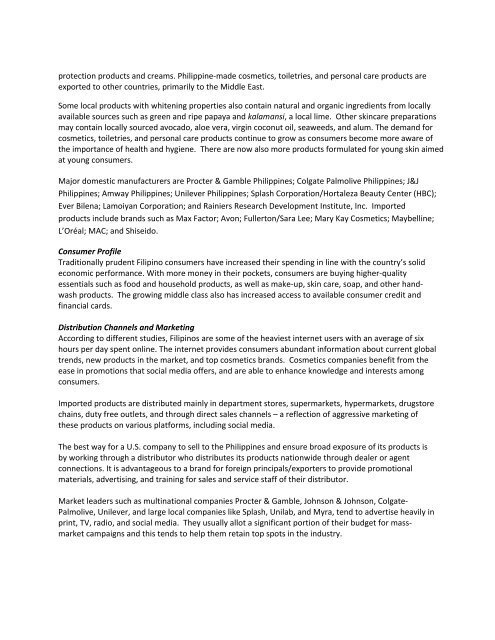Asia Personal Care & Cosmetics Market Guide 2016
AsiaCosmeticsMarketGuide
AsiaCosmeticsMarketGuide
You also want an ePaper? Increase the reach of your titles
YUMPU automatically turns print PDFs into web optimized ePapers that Google loves.
protection products and creams. Philippine-made cosmetics, toiletries, and personal care products are<br />
exported to other countries, primarily to the Middle East.<br />
Some local products with whitening properties also contain natural and organic ingredients from locally<br />
available sources such as green and ripe papaya and kalamansi, a local lime. Other skincare preparations<br />
may contain locally sourced avocado, aloe vera, virgin coconut oil, seaweeds, and alum. The demand for<br />
cosmetics, toiletries, and personal care products continue to grow as consumers become more aware of<br />
the importance of health and hygiene. There are now also more products formulated for young skin aimed<br />
at young consumers.<br />
Major domestic manufacturers are Procter & Gamble Philippines; Colgate Palmolive Philippines; J&J<br />
Philippines; Amway Philippines; Unilever Philippines; Splash Corporation/Hortaleza Beauty Center (HBC);<br />
Ever Bilena; Lamoiyan Corporation; and Rainiers Research Development Institute, Inc. Imported<br />
products include brands such as Max Factor; Avon; Fullerton/Sara Lee; Mary Kay <strong>Cosmetics</strong>; Maybelline;<br />
L’Oréal; MAC; and Shiseido.<br />
Consumer Profile<br />
Traditionally prudent Filipino consumers have increased their spending in line with the country’s solid<br />
economic performance. With more money in their pockets, consumers are buying higher-quality<br />
essentials such as food and household products, as well as make-up, skin care, soap, and other handwash<br />
products. The growing middle class also has increased access to available consumer credit and<br />
financial cards.<br />
Distribution Channels and <strong>Market</strong>ing<br />
According to different studies, Filipinos are some of the heaviest internet users with an average of six<br />
hours per day spent online. The internet provides consumers abundant information about current global<br />
trends, new products in the market, and top cosmetics brands. <strong>Cosmetics</strong> companies benefit from the<br />
ease in promotions that social media offers, and are able to enhance knowledge and interests among<br />
consumers.<br />
Imported products are distributed mainly in department stores, supermarkets, hypermarkets, drugstore<br />
chains, duty free outlets, and through direct sales channels – a reflection of aggressive marketing of<br />
these products on various platforms, including social media.<br />
The best way for a U.S. company to sell to the Philippines and ensure broad exposure of its products is<br />
by working through a distributor who distributes its products nationwide through dealer or agent<br />
connections. It is advantageous to a brand for foreign principals/exporters to provide promotional<br />
materials, advertising, and training for sales and service staff of their distributor.<br />
<strong>Market</strong> leaders such as multinational companies Procter & Gamble, Johnson & Johnson, Colgate-<br />
Palmolive, Unilever, and large local companies like Splash, Unilab, and Myra, tend to advertise heavily in<br />
print, TV, radio, and social media. They usually allot a significant portion of their budget for massmarket<br />
campaigns and this tends to help them retain top spots in the industry.

















